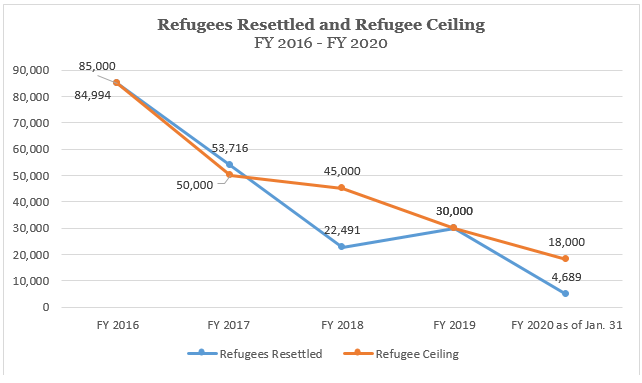The Guaranteed Refugee Admissions Ceiling Enhancement Act (GRACE Act), H.R. 2146 and S. 1088, would require the President to set the annual ceiling of refugees to at least 95,000, which would reverse the trend in recent years of a lower and lower refugee cap. The bill was introduced on April 9, 2019 by Representative Zoe Lofgren (D-California) in the U.S. House of Representatives and by Senator Edward J. Markey (D- Massachusetts) in the Senate.
What does the bill do?
- Requires an annual admission floor in the Presidential Determination of refugees to be at least 95,000 refugees per year. The Refugee Act of 1980 requires that the maximum number of refugees accepted to the U.S. each year to be set by the President, in consultation with Congress, in a “Presidential Determination.”
- Requires federal officials responsible for refugee admissions or resettlement to treat the admission numbers as “numerical goals.” This language is notable because it encourages the government to treat the refugee admissions ceiling as a goal to be achieved.
- Mandates quarterly reports to Congress on multiple aspects of refugee admissions such as the number of refugees admitted, length of time for various aspects of processing, and a plan for ensuring that the government reaches the numeric goals. These reports would ensure oversight, accountability, and operational integrity to achieve the admission goals for refugee resettlement established in the Presidential Determination.
What are the bill’s benefits?
- The GRACE Act recognizes and honors a fundamental American value, the protection of those who have a well-founded fear of persecution. The protection of those facing persecution, including religious persecution, has been part of the founding of the nation and has historically had broad bipartisan support. The Act recognizes the current unprecedented number of refugees in the world who need to be resettled.
- The Act advances U.S. security interests. When the U.S. engages in international conflict zones and needs to recruit national citizens to assist, those citizens will be more likely to step forward if they understand that the United States will offer them protection if their service to the U.S. puts them or their family in danger of persecution, injury, or death.
- The GRACE Act sends a clear message to the world and to countries that host large numbers of refugees, that the U.S. is prepared to share responsibility for protecting refugees around the world and set an example by setting an admission floor for refugees and leading in the number of refugees resettled.
Background
A “refugee” is a person outside the country of his or her nationality, who is unable or unwilling to return to that country because of persecution or a well-founded fear of persecution based on race, religion, nationality, membership in a particular social group, or political opinion.
Although historically the U.S. has resettled more refugees than any other country, its resettlement program has not kept up with the increase of the global refugee population. Approximately 25.9 million refugees exist worldwide, as of June 2019. For 202o, the United Nations High Commissioner for Refugees (UNHCR) has projected 1.4 million refugees who will need “global resettlement.” Historically, the U.S. has resettled just a small fraction of the overall number of refugees. The 27-resettlement countries around the world combined generally resettle less than 1% of the total number of refugees.
In FY 2016, the U.S. resettled nearly 85,000 refugees. The refugee ceiling for FY 2017 was originally set at 110,000 refugees, but the Trump administration reduced the admission’s cap to 50,000 refugees. The refugee ceiling has continued to decline. In FY 2018, the cap was 45,000, in FY 2019 30,000, and in FY 2020 only 18,000 — the lowest number since the enactment of the Refugee Act of 1980.

Source: Refugee Processing Center
For more information about refugee resettlement, the National Immigration Forum has posted a fact sheet here.
Author: Dan Kosten


